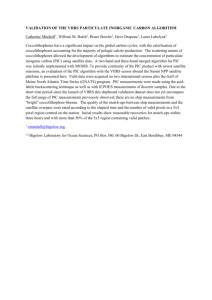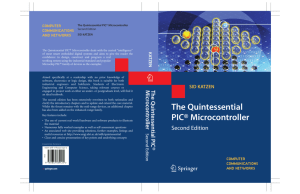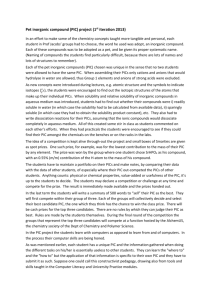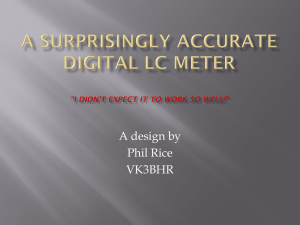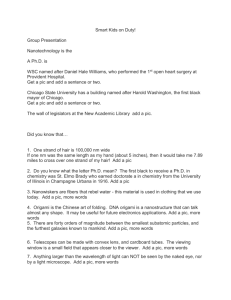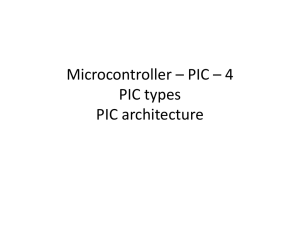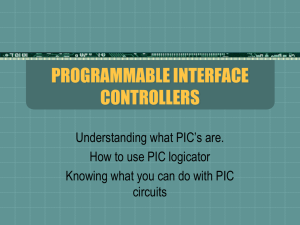PIC Micro controllers1
advertisement
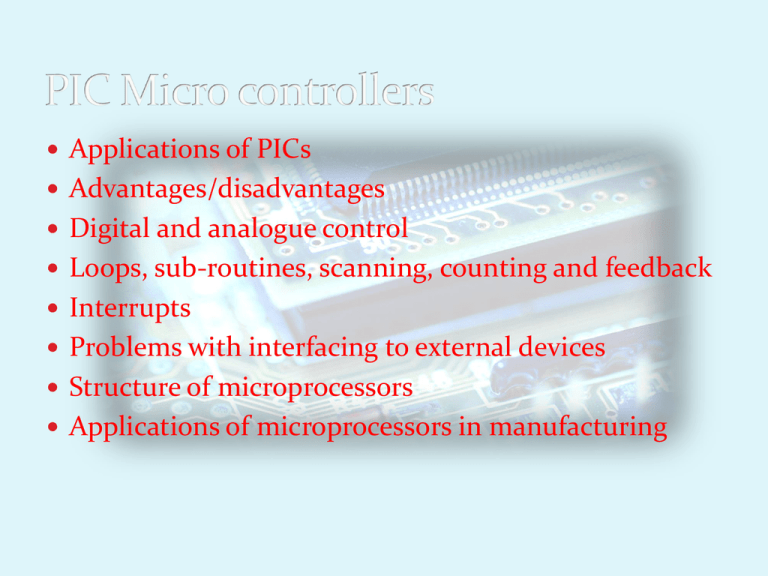
Applications of PICs Advantages/disadvantages Digital and analogue control Loops, sub-routines, scanning, counting and feedback Interrupts Problems with interfacing to external devices Structure of microprocessors Applications of microprocessors in manufacturing Programmable Integrated Circuit/Programmable Interface Controller Capable of storing instructions in the form of a programme Can switch output devices on and off in sequence in response to input signals Can be programmed and erased up to 100,000 times Require a supply voltage of 3 to 5.5V Available as 8, 14, 18, 28 and 40 pin DIL packages Applications include alarm systems, medical equipment, vending machines, traffic lights, cash machines, petrol pumps….. Advantages One PIC can replace a wide variety of separate electronic components or circuits Advantages One PIC can replace a wide variety of separate electronic components or circuits Increase d product reliability through the use of less components Advantages One PIC can replace a wide variety of separate electronic components or circuits Increase d product reliability through the use of less components Reduced stock levels Advantages One PIC can replace a wide variety of separate electronic components or circuits Increase d product reliability through the use of less components Reduced stock levels Simplified product assembly and smaller end products Advantages One PIC can replace a wide variety of separate electronic components or circuits Increase d product reliability through the use of less components Reduced stock levels Simplified product assembly and smaller end products Greater product flexibility, adaptability resulting in rapid product changes Advantages One PIC can replace a wide variety of separate electronic components or circuits Increase d product reliability through the use of less components Reduced stock levels Simplified product assembly and smaller end products Greater product flexibility, adaptability resulting in rapid product changes Disadvantages Advantages Disadvantages One PIC can replace a wide Knowledge of programming variety of separate electronic components or circuits Increase d product reliability through the use of less components Reduced stock levels Simplified product assembly and smaller end products Greater product flexibility, adaptability resulting in rapid product changes required Advantages Disadvantages One PIC can replace a wide Knowledge of programming variety of separate electronic components or circuits Increase d product reliability through the use of less components Reduced stock levels Simplified product assembly and smaller end products Greater product flexibility, adaptability resulting in rapid product changes required PICs have a low power output and so require interfacing circuitry to drive higher current devices For traditional electronics this would require a variety of components designed through a circuit diagram Microcontroller diagrams System diagrams can still be used to develop designs, but INPUT PROCESS OUTPUT the process element would be replaced with lines of programme rather INPUT PIC MICROCONTROLLER OUTPUT than a list of components Although still requiring a circuit, processing would be programmed with all previous components being replaced by a single PIC Inside a PIC Like all computers, a PIC micro controller CPU has a Central Processing Unit, Random Access Memory, Read Only RAM Memory, a clock and IO Input/Output ports. The key difference is that all of these are ROM built into one IC, rather than a variety of individual ICs FLASH One Time Programmable (OTP) Most common form Can be programmed Can be erased up to only once More suited to mass produced products 100,000 times Reprogrammed by simply downloading the new programme to the IC Offer flexibility to manufactures Terminator Subroutine Decision Input/Output Process Programming can be via a flow chart sequence or BASIC programming language Intel Museum - How Microprocessors Work #1 How Do Microprocessors Work??

